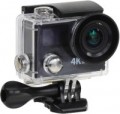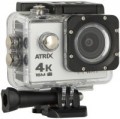Dust-, moisture-proof of case
The degree of dust and water protection of the protective case supplied with the camera.
Protected case will save your camera from dust, water, temperature changes, shocks, etc. The specific degree of protection is indicated according to the international IP (Ingress Protection Rating) system, according to which each device is assigned a code of the form IPXX, where X is replaced by specific numbers. The first of them characterizes the protection against the penetration of foreign objects (from 0 to 6, where 0 is no protection). Usually, in boxes for action cameras, this indicator does not go below 5, because otherwise the container would have too large gaps, and its use simply would not make sense. Level 5 provides dust resistance — dust can get inside the case, but in small quantities that do not affect the device inside. Level 6 corresponds to complete imperviousness to dust.
The second digit is protection against liquid ingress (from 0 to 8, where 0 is no protection). Usually, the minimum level of protection against water is 6.
6 — protection against short-term immersion (for example, falling into a sea wave);
7 — protection against temporary immersion under water (up to 30 minutes) to a shallow depth (up to 1 metre), without continuous operation in immersed mode;
8 — protection against immersion to a depth of more than 1 metre for a time of more than 30 m, with the possibility of continuous
...operation underwater. The specific level of protection of level 8 can be quite impressive — up to the possibility of diving to several tens of metres.
Note that protective cases for action cameras can be sold separately. Therefore, if the capabilities of the complete container do not suit you, there may be a more secure case on the market. On the other hand, in general, it is still more convenient to buy such an accessory immediately with a camera — so as not to waste time and effort on choosing the right protective case.Quad HD
The ability of the camera to shoot QuadHD video.
This standard includes an extensive set of resolutions — from 1440 to 3456 pixels horizontally and from 1440 to 2160 pixels vertically, with almost two dozen intermediate options. It is a rather specific transitional option between the relatively inexpensive FullHD 1080p and the demanding UltraHD 4K, allowing you to shoot higher resolution video than 1080p without significantly increasing the cost of equipment. Note that pure QuadHD resolutions are rare in TVs and monitors, but modern technologies make it possible to comfortably watch videos of this format on any high-resolution screen.
Another important parameter given in this paragraph is the frame rate. The higher it is, the smoother the movement in the frame will be, and the details in dynamic scenes will be visible clearly. For example, a filming speed of
25 fps or
30 fps approximates the standard frame rate in film and television; such an image is quite viewable, but fast-moving objects in the frame will look blurry. With an increase in speed to
60 fps, this effect becomes almost imperceptible. The highest QuadHD frame rate found in modern action cameras is
120 fps; this frequency is used when shooting slow-motion video (as well as models with a frequency of
100 fps) because at a n
...ormal playback speed, 60 fps is enough.Slow motion
Frame rate supported by the camera when
shooting in slow motion.
In general, such shooting is called “high-speed” because it is carried out at an increased frame rate (more than 60 fps). As a result, when played back at normal speed (60 fps and below), the video looks slow hence the name. This kind of slow-motion can be used just for fun, as an artistic technique, and even for scientific purposes — to capture movement that is too fast for the human eye. In any case, the higher the slow-mo frame rate, the more you can slow down the video and the more advanced the camera is in this regard. On the other hand, the higher the frame rate, the more performant the graphics part should be; and this, in turn, affects the price of the device, sometimes quite noticeably.
We also note that slow-mo shooting may be available only at certain resolutions, not always at maximum. These points can be directly specified in the specs of the action camera.
Megapixels
The number of megapixels in the action camera sensor, in other words, the resolution of this sensor(1 megapixel is 1 million photosensitive points).
There is an opinion that the higher the resolution, the better the image quality. It is true from the point of view that manufacturers are trying to install high-resolution sensors in advanced cameras. At the same time, there are no strict dependencies here, and from the technical point of view, the number of megapixels determines only the maximum image resolution that can be captured using this sensor. The quality of this picture will depend both on several features of the sensor itself (size, type, special design solutions), and the specs of the camera. So when choosing, you should focus not so much on the resolution of the image sensor, but on the general class of the camera and reviews with examples of footage.
Photo resolution
The maximum resolution at which the action camera can take photos. Specified in pixels horizontally and vertically.
This parameter is directly related to the resolution of the image sensor(see above): the total number of pixels in the photo, usually, corresponds to the number of pixels in the sensor. For example, a photo resolution of 4608x3456 corresponds to a sensor of 15925248 pixels, or approximately 16 megapixels. If the number of pixels in the photo is greater than the claimed resolution of the sensor, then the manufacturer uses software tricks that allow you to improve the photo resolution to a higher one than originally. This reduces the cost of devices but also affects the quality of images.
Theoretically, high-resolution images can provide good detail, but in fact, much depends on the specs of the sensor (primarily physical size) and image processing features.
Display
— Diagonal. The larger the screen, the more convenient it is to watch (and also to control if the display is touch-sensitive). On the other hand, the diagonal of the
built-in display directly affects the size of the case, and action cameras should be quite compact. Thus, there are practically no screens larger than 2.5" in modern action cameras.
— Resolution. Theoretically, the higher the resolution, the clearer and better image the screen produces. On the other hand, displays in action cameras are designed mainly for menu operation and footage preview — and for these purposes, especially high resolutions are not needed. For models with two screens, the rear display is considered the main display.
— Touch screen. Display equipped with a sensor and responsive to touch like in smartphones/tablets. Control through such a display is simpler and more intuitive than using buttons, rotary knobs, etc. On the other hand, for more or less convenient control, the
touch screen must be quite large, which affects the dimensions of the entire camera.
Front screen
The presence in the camera of a screen mounted on the front panel, next to the lens. Other displays may not be present at all; in such cases, the diagonal, resolution and other parameters are given for
the front screen.
It is worth noting that most often the simplest black-and-white displays are installed on the front panel, suitable only for text and basic graphic information. However, even on such a screen, you can display a wide variety of service data: the current mode of operation (photo, video, standby), the resolution used, the shooting time, the amount of free space on the drive, etc. But more advanced displays are not used as front displays: a full-colour screen is needed only for taking a selfie, and for this you can use a
remote display with a remote control(see "Control") or a smartphone connected to the camera.
Speaker
Speaker or speakers installed directly in the camera body. This function is mainly intended to allow you to view footage with sound without connecting headphones or external speakers. However the
built-in speakers do not have decent volume or general sound quality — nevertheless, they allow you to determine what the camera “heard” as a whole, whether sound recording was turned on, whether individual ambient sounds got into the recording, etc.
Max. memory card capacity
The largest memory card capacity supported by the camera model.
This limitation is due to two points. First, the larger the drive, the more computing power is required to use it. Secondly, each type of memory card has its maximum capacity. For example, the capacity of an SD HC card cannot exceed 32 GB, larger drives already belong to the SD XC standard, and if it is not supported, the maximum card capacity cannot exceed 32 GB.
It is strongly not recommended to exceed the maximum allowable capacity: even if the card is recognized by the device, its normal operation is not guaranteed.

